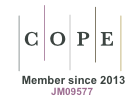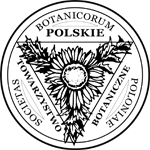The genetic polymorphism between the wild species and cultivars of rye Secale cereale L.
Abstract
Keywords
Full Text:
PDFReferences
Cuadrado A, Jouve N. Evolutionary trends of different repetitive DNA sequences during speciation in the genus Secale. J Hered. 2002;93(5):339–345. http://dx.doi.org/10.1093/jhered/93.5.339
Ma R, Yli-Mattila T, Pulli S. Phylogenetic relationships among genotypes of worldwide collection of spring and winter ryes (Secale cereale L.) determined by RAPD-PCR markers. Hereditas. 2004;140(3):210–221. http://dx.doi.org/10.1111/j.1601-5223.2004.01844.x
Shang HY, Wei YM, Wang XR, Zheng YL. Genetic diversity and polygenetic relationships in the genus Secale L. (rye) based on Secale cereale microsatellite markers. Genet Mol Biol. 2006;29(4):685–691. http://dx.doi.org/10.1590/S1415-47572006000400018
Stojałowski S, Łapiński M, Masojć P. RAPD markers linked with restorer genes for the C-source of cytoplasmic male sterility in rye (Secale cereale L.). Plant Breed. 2004;123(5):428–433. http://dx.doi.org/10.2478/v10129-011-0009-y
Myśków B, Stojałowski S, Milczarski P, Masojć P. Application of RAPD linkage map for identification of sprouting resistance genes in rye (Secale cereale L.). Annales Universitatis Mariae Curie-Skłodowska. Sectio E Agricultura. 2004;59(3):1289–1296.
Chrząstek M. Using biochemical and molecular markers for localization of Sec genes on chromosomes of rye (Secale cereale L.) cv. Dankowskie Zlote. Annales Universitatis Mariae Curie-Skłodowska. Sectio E Agricultura. 2004;59(1):1285–1292.
Börner A, Korzun V, Voylokov AV, Worland AJ, Weber WE . Genetic mapping of quantitative trait loci in rye (Secale cereale L.). Euphytica. 2000;116(3):203–209. http://dx.doi.org/10.1023/a:1004052505692
Börner A, Korzun V, Polley A, Malyshev S, Melz G. Genetics and molecular mapping of a male fertility restoration locus (Rfg1) in rye (Secale cereale L.). Theor Appl Genet. 1998;97(1–2):99–102. http://dx.doi.org/10.1007/s001220050871
Kubicka H. Dziedziczenie cech u żyta (Secale cereale L.). In: Górny AG, editor. Zarys genetyki zbóż. Tom 1. Jęczmień, pszenica i żyto. Poznań: Instytut Genetyki Roślin Polskiej Akademii Nauk; 2004: p. 329–424. (Treatises and Monographs – Institute of Plant Genetics; vol 13).
Dopierała P, Bujak H, Wilde P, Bajgain P, Dopierała A, Gordillo A, et al. Using inbred lines from ancient Polish population varieties to broaden genetic diversity in hybrid rye breeding. In: Proceedings of the International Conference on Rye Breeding and Genetics; 2015 Jun 24–26; Wrocław, Poland. Wrocław: Wydawnictwo Uniwersytetu Przyrodniczego we Wrocławiu; 2015. p. 44.
Targońska M, Bolibok-Brągoszewska H, Rakoczy-Trojanowska M. Assessment of genetic diversity in Secale cereale based on SSR markers. Plant Mol Biol Report. 2016;34(1):37–51. http://dx.doi.org/10.1007/s11105-015-0896-4
Feuillet C, Langridge P, Waugh R. Cereal breeding takes a walk on the wild side. Trends Genet. 2007;24(1):24–32. http://dx.doi.org/10.1016/j.tig.2007.11.001
Mackiewicz-Karolczak D, Broda Z. Ocena efektywności krzyżowań międzygatunkowych w rodzaju Secale. Biuletyn Instytutu Hodowli i Aklimatyzacji Roślin. 2002;221:73–82.
Ćwiklińska A, Broda Z, Bocianowski J. Analiza porównawcza cech dzikich gatunków rodzaju Secale L. w celu poszerzenia zmienności genetycznej przydatnej w hodowli. Biuletyn Instytutu Hodowli i Aklimatyzacji Roślin. 2009;252:119–137.
Knüpffer H. Rye genetic resources in the world’s genebanks. In: Proceedings of the international conference “More attention to rye”; 2011 Oct 6–8; Tartu, Estonia. 2011. p. 1–9.
Loarce Y, Gallego R, Ferrer E. A comparative analysis of the genetic relationships between rye cultivars using RFLP and RAPD markers. Euphytica. 1996;88(2):107–115. http://dx.doi.org/10.1007/bf00032441
Caetano-Anollés G, Bassam BJ, Gresshoff PM. DNA amplification fingerprinting using very short arbitrary oligonucleotide primers. Nat Biotechnol. 1991;9:553–557. http://dx.doi.org/10.1038/nbt0691-553
Liersch A, Popławska W, Ogrodowczyk M, Krótka K, Bartkowiak-Broda I, et al. Oszacowanie dystansu genetycznego linii rodzicielskich mieszańców F1 rzepaku ozimego oraz określenie związku z dystansem fenotypowym i efektem heterozji. Rośliny Oleiste – Oilseed Crops. 2010;31(2):229–241.
Kuczyńska A, Bocianowski J, Masojć P, Surma M, Adamski T. Zastosowanie markerów RAPD do określenia podobieństwa genetycznego odmian jęczmienia ozimego (Hordeum vulgare L.). Biuletyn Instytutu Hodowli i Aklimatyzacji Roślin. 2003;226/227(1):81–85.
Gradzielewska A, Tyrka M, Leśniowska-Nowak J, Nazaruk J. Genetic relationships among representatives of Dasypyrum, Secale and Triticum species revealed with RAPD and ISSR markers. Not Bot Horti Agrobot Cluj Napoca. 2014;42(2):420–430. http://dx.doi.org/10.15835/nbha.42.2.9662
Ćwiklińska A, Broda Z, Bocianowski J, Dobrzycka A. The usefulness of RAPD and AFLP markers for determining genetic similarity in rye (Secale L.) species and subspecies. Acta Biol Crac Ser Bot. 2010;52(1):19–25. http://dx.doi.org/10.2478/v10182-010-0003-y
Broda Z, Kurasiak-Popowska D, Kowalska A, Ćwiklińska A. Analiza podobienstwa genetycznego wybranych gatunkow w rodzaju Secale. Biuletyn Instytutu Hodowli i Aklimatyzacji Roślin. 2008;247:65–71.
Nei M, Li WH. Mathematical model for studying genetic variation in terms of restriction. Proc Natl Acad Sci USA. 1979;76(10):5269–5273. http://dx.doi.org/10.1073/pnas.76.10.5269
Liu D, Zhang H, Zhang L, Yuan Z, Hao M, Zheng Y. Distant hybridization: a tool for interspecific manipulation of chromosomes. In: Pratap A, Kumar J, editors. Alien gene transfer in crop plants. Vol. 1. Innovations, methods and risk assessment. New York, NY: Springer; 2014. p. 25–42. http://dx.doi.org/10.1007/978-1-4614-8585-8_2
Meier S, Kunzmann R, Zeller FJ. Genetic variation in germplasm accessions of Secale vavilovii Grossh. Genet Resour Crop Evol. 1996;43:91–96. http://dx.doi.org/10.1007/bf00126946
Molski BA, Luczak W, Zych J. Protein quantity and quality in rye collections and in agricultural production in Poland. In: Proceedings: Eucarpia Meeting of the Cereal Section on Rye; 1985 Jun 11–13; Svalof, Sweden. 1985. p. 491–523.
Plarre W. Breeding methodology for rye with resistance to sprouting. Cereal Res Commun. 1980;8(1):265–274.
Solodukhina OV, Kobyljanski VD. Problems of winter rye breeding for resistance to leaf and stem rusts. Plant Breeding and Seed Science. 2003;48(2):87–97.
Wehling P, Linz A, Hackauf B, Roux SR, Ruge B, Klocke B. Leaf-rust resistance in rye (Secale cereale L.). 1. Genetic analysis and mapping of resistance genes Pr1 and Pr2. Theor Appl Genet. 2003;107:432–438. http://dx.doi.org/10.1007/s00122-003-1263-7
Mackiewicz D, Broda Z. Ocena przydatności hodowlanej mieszańców żyta uprawnego Secale cereale (L.) z dzikimi gatunkami z rodzaju Secale. Biuletyn Instytutu Hodowli i Aklimatyzacji Roślin. 2004;231:265–277.
Reiman-Philipp R. Perennial spring rye as a crop alternative. Journal of Agronomy and Crop Science. 1986;157:281–285. http://dx.doi.org/10.1111/j.1439-037x.1986.tb00077.x
Hammer K. Breeding system and phylogenetic relationships in Secale L. Biol Zent Bl. 1990;109:45–50.
Geiger HH, Miedaner T. Rye breeding. In: Carena MJ, editor. Cereals. New York, NY: Springer; 2009. p. 157–181. (Handbook of Plant Breeding; vol 3).
Węgrzyn S. Synteza i wyodrębnianie materiałów wyjściowych dla hodowli zbóż. Zeszyty Problemowe Instytutu Hodowli i Aklimatyzacji Roślin. 1988:33–40.
Rzepka-Plevneš D, Tomczak P, Pławska M. Możliwości wykorzystania mieszańców międzygatunkowych żyta w hodowli odmian plennych i odpornych na mączniaka prawdziwego (Erysiphe graminis DC. f. sp. secalis Marchal). Hodowla Roślin, Aklimatyzacja i Nasiennictwo. 1995;39(6):67–80.
Tester M, Langridge P. Breeding technologies to increase crop production in a changing world. Science. 2010;327:818- 822. http://dx.doi.org/10.1126/science.1183700
Peleman JD, van der Voort JR. Breeding by design. Trends Plant Sci. 2003;8(7):330–334. http://dx.doi.org/10.1016/s1360-1385(03)00134-1
Varshney RK, Hoisington DA, Tyagi AK. Advances in cereal genomics and applications in crop breeding. Trends Biotechnol. 2006;24(11):490–499. http://dx.doi.org/10.1016/j.tibtech.2006.08.006
Williams JGK, Bubelik AR, Lival K, Rafalski JA, Tingey SV. DNA polymorphisms amplified by arbitrary primers are useful as genetic markers. Nucleic Acids Res. 1990;18:6531–6535. http://dx.doi.org/10.1093/nar/18.22.6531
Sztuba-Solińska J. Systemy markerów molekularnych i ich zastosowanie w hodowli roślin. Kosmos. 2005;54:227–239.
Li Y, Haseneyer G, Schön CC, Ankerst D, Korzun V, Wilde P, et al. High levels of nucleotide diversity and fast decline of linkage disequilibrium in rye (Secale cereale L.) genes involved in frost response. BMC Plant Biol. 2011;11(1):6. http://dx.doi.org/10.1186/1471-2229-11-6
Miedaner T, Hübner M, Korzun V, Schmiedchen B, Bauer E, Haseneyer G, et al. Genetic architecture of complex agronomic traits examined in two testcross populations of rye (Secale cereale L.). BMC Genomics. 2012;13:706. http://dx.doi.org/10.1186/1471-2164-13-706
Hegde SG, Valkoun J, Waines JG. Genetic diversity in wild and weedy Aegilops, Amblyopyrum, and Secale species – a preliminary study. Crop Sci. 2002;42:608–614. http://dx.doi.org/10.2135/cropsci2002.0608
Skuza L, Rogalska SM, Bocianowski J. RFLP analysis of mitochondria DNA in the genus Secale. Acta Biol Crac Ser Bot. 2007;49(1):77–87.
Chikmawati T, Skovmand B, Gustafson JP. Phylogenetic relationships among Secale species revealed by amplified fragment length polymorphism. Genome. 2005;48:792–801. http://dx.doi.org/10.1139/g05-043
DOI: https://doi.org/10.5586/aa.1652
|
|
|






